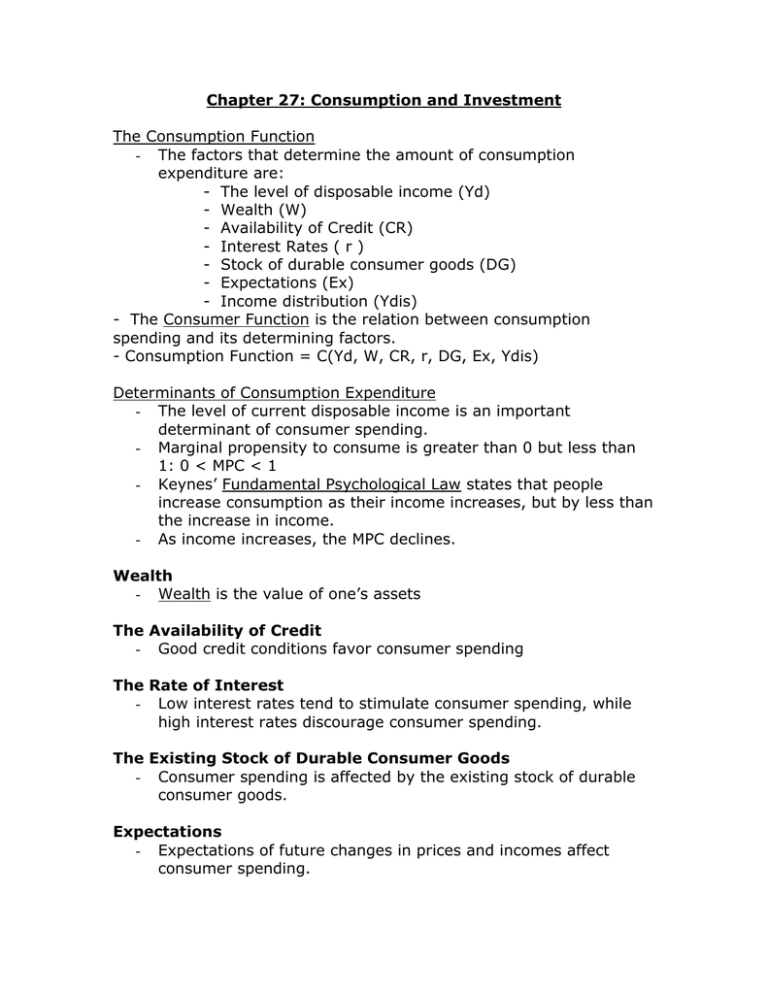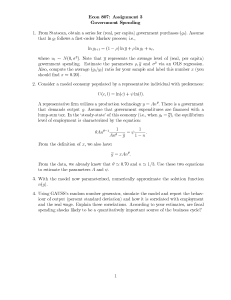Chapter 27: Consumption and Investment The Consumption Function
advertisement

Chapter 27: Consumption and Investment The Consumption Function - The factors that determine the amount of consumption expenditure are: - The level of disposable income (Yd) - Wealth (W) - Availability of Credit (CR) - Interest Rates ( r ) - Stock of durable consumer goods (DG) - Expectations (Ex) - Income distribution (Ydis) - The Consumer Function is the relation between consumption spending and its determining factors. - Consumption Function = C(Yd, W, CR, r, DG, Ex, Ydis) Determinants of Consumption Expenditure - The level of current disposable income is an important determinant of consumer spending. - Marginal propensity to consume is greater than 0 but less than 1: 0 < MPC < 1 - Keynes’ Fundamental Psychological Law states that people increase consumption as their income increases, but by less than the increase in income. - As income increases, the MPC declines. Wealth - Wealth is the value of one’s assets The Availability of Credit - Good credit conditions favor consumer spending The Rate of Interest - Low interest rates tend to stimulate consumer spending, while high interest rates discourage consumer spending. The Existing Stock of Durable Consumer Goods - Consumer spending is affected by the existing stock of durable consumer goods. Expectations - Expectations of future changes in prices and incomes affect consumer spending. Income Distribution (The Robin Hood Effect) - A redistribution of income from high-income earners to lowincome earners increases consumer spending. This can be called the Robin Hood Effect. A Shift of the Consumption Function versus a Movement Along the Consumption Function - A change in income causes a movement along the consumption curve - A change in a non-income determinant of consumption causes the consumption curve to shift. The Life-Cycle and Permanent-Income Hypotheses - The Current-Income Hypothesis states that a change in a nonincome determinant of consumption causes the incomeconsumption relation to change. - The Permanent-Income Hypothesis and the Life-Cycle Hypothesis state that consumption may depend more on permanent income than on current income. Investment Demand - Investment spending accounts for about 15% of aggregate spending. Determinants of Investment Spending - The factors affecting the level of investment spending are: o The Rate of Interest ( r ) o Retained Earnings (RE) o The level of profits (п) o Expectations (Ex) o The rate of technological change (Tc) o The level of national income (Y) o The rate of change of national income (Ŷ) - The Investment Function is the relation between investment spending and its determining factors. Investment Function = I (r, RE, п, Ex, Tc, Y, Ŷ) If we assume all the determinants of investment except the rate of interest are fixed then the investment function is: I = I( r ) The Rate of Interest - Low investment rates encourage investment while high interest rates discourage investment. When interest rates are higher then expect rate of return on investment, it means the investment is not profitable. As the rate of interest falls, the level of investment rises. Economists use the term Marginal Efficiency of Investment (MEI) to summarize this inverse relation between rate of interest and the level of investment. Retained Earnings - The amount of retained earnings affects the level of investment. The Level of Profits - High levels of profits may encourage investment spending. Expectations - Business expectations and confidence influence investment. The Rate of Technological Change - The rate of technological change and the rate of introduction of new products affect investment. The Level of Income - A direct relation exists between the level of income and the level of investment. The Rate of Change of National Income - Not only the level of income but also the change in income will affect investment. - Investment resulting from changes in income is called Induced Investment



